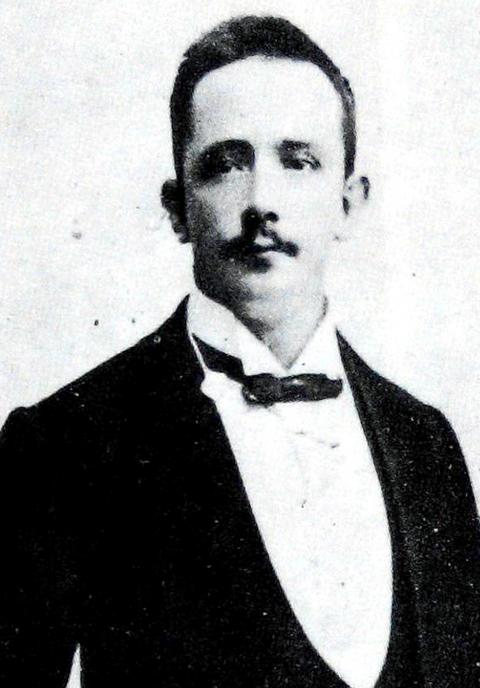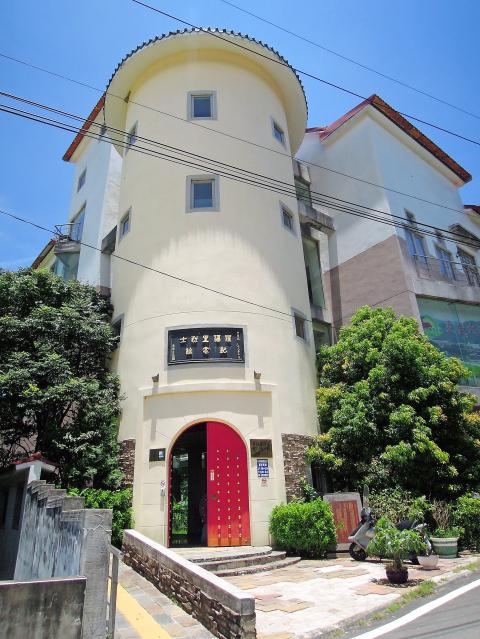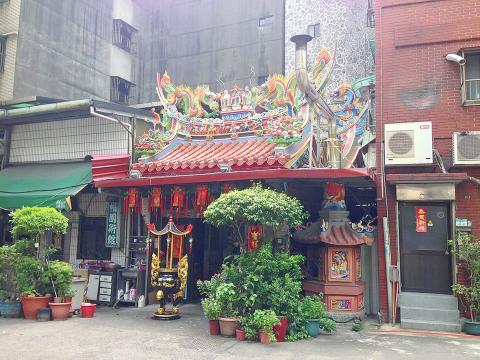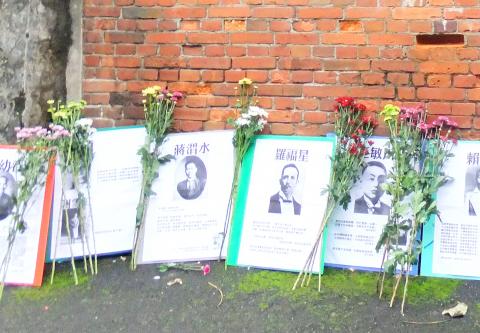Dec. 18 to Dec. 24
Although his multiple uprisings barely got off the ground, Lo Fu-hsing (羅福星) stood defiant while facing his Japanese captors. Arrested in Tamsui on Dec. 18, 1913, he was sentenced to death the following March.
According to Japanese records, a prison guard asked him if he thought what he did was an unpardonable crime.

Photo courtesy of Wikimedia Commons
“I’m just exercising my rights to freedom and equality,” Lo said. “I don’t think that constitutes criminal activity.
The guard told Lo that the Japanese government was providing Taiwanese with a good living, “but you claim the opposite, and that is merely your personal bias. Will you still not admit your crimes?”
Lo answered that he accepted the verdict and if he wasn’t put to death he would not be able to face his comrades who had already been executed.

Photo: Tsai Cheng-min, Taipei Times
“No matter how harsh the punishment, I do not think I committed any crime,” he repeated.
FAILURE TO LAUNCH
Lo was born in today’s Jakarta, the son of a Chinese businessman and a local woman with partial Dutch ancestry — hence his unique appearance. He returned to China at a young age, and in 1903 followed his grandfather to Taiwan at the age of 18. They settled in Miaoli.

Photo courtesy of Wikimedia Commons
“Although he personally experienced the pain of Taiwanese suffering under Japanese rule, it had yet to awaken his revolutionary spirit,” writes Chin Yi-hui (覃怡輝) in A Study of Lo Fu-hsing’s Anti-Japanese Revolution (羅福星抗日事件革命研究). “His first response was to run away from the suffering, and that’s why he and his grandfather left Taiwan.”
The awakening happened when Lo returned to China in 1906 and joined the Tongmenghui (同盟會, “united league”), a secret society dedicated to the overthrow of the Qing Dynasty. He spent the next few years teaching in Southeast Asia while secretly recruiting troops, leading them back to China to take part in the Second Guangzhou Uprising in April 1911. Lo was among the few to survive this disastrous battle and the Qing Dynasty fell a year later.
He and a few comrades then took the revolution to Taiwan, setting up a Tongmenghui branch in Taipei and carrying out underground activities in today’s Dadaocheng (大稻埕) area in Taipei. Due to his personal connections during his time in Taiwan, Lo had been able to recruit 500 men by April 1913.

Photo: Shih Chih-ju, Taipei Times
“Lo returned to Taiwan a completely different man,” Chin writes.
His first three attempts were suppressed before they got off the ground because Japanese authorities learned of the plans. They were at least twice sold out by their comrades. In September 1913, rebels broke into a police station in today’s Dahu Township (大湖) in Miaoli and made off with a cache of weapons. The police immediately searched the area and captured eight rebels, who were tortured into leaking information. By October, they had essentially thwarted the entire plan.
Lo fled to Tamsui and was waiting for a chance to sail to China when authorities caught him and found on him a notebook containing a list of comrades, leading to mass arrests.
SHIFT IN LEGACY
As customary for Taiwan’s historical figures, Lo’s legacy has stirred controversy throughout the decades, especially due to his ties to China. Chiang Kai-shek (蔣介石) officially commended him and he was considered a national hero that all schoolchildren learned about. On the 100th anniversary of his execution, then-president Ma Ying-jeou (馬英九) paid his respects, noting that “from these events in history, we can see the close ties between Taiwan and the Republic of China.”
Critics, on the other hand, maintain that Lo’s heroic image was built up by the Chinese Nationalist Party (KMT) to further their ideology. This ideological struggle has led to the obscuring of Lo’s full story.
Sung Pei-fen (宋佩芬) and Chang Wei-hsi (張韡曦) look at the shift in Lo’s portrayal in the study The Narrative Changes of Taiwanese History(台灣史的詮釋轉變) by examining several junior high textbooks.
History (歷史), published in 1997, emphasizes Lo’s connections with Sun Yat-sen’s (孫逸仙) revolution and cites his exploits as the prime example for anti-Japanese armed revolts during the early years of colonial rule.
Published the same year, Understanding Taiwan (認識台灣) merely lists Lo among the 20 people who were executed for their role in the Miaoli Incident, but notes that the incident was minzu (民族) in nature. Minzu is a politically-charged phrase that is often used to represent ethnic Chinese worldwide, but can also mean ethnic in general or nationalist. It’s unclear what the author means here, as many educated Taiwanese did see China as the motherland before they became disillusioned by KMT misrule.
The 2008 history textbooks also downplay the China connection, showing Lo simply as a revolutionary in Taiwan. However, regarding Lo’s uprising, a social studies textbook states: “Due to the influence of the revolution in China, there were many anti-Japanese revolts that carried minzu characteristics.” Again, this raises more questions than answers.
With textbooks unreliable, fortunately there are primary sources. It’s clear that Lo fully identified with the Republic of China (ROC) and sought to “recover” Taiwan on behalf of China and liberate his fellow Han Chinese from foreign rule. But in his written confession, he cites the various injustices the Japanese inflicted on the Taiwanese as the main impetus for his actions, which he details at length.
“If we compare Taiwan to the human body, the Japanese are only stripping away at its skin right now. In four or five years, they will surely move on to the flesh and bones, and in eight or 10 years, they will be sucking on the marrow.”
His concerns did come true as Japanization policies began in the 1930s that sought to completely eradicate Taiwanese culture.
No matter his political ideology, Lo seemed to be a fearless man who did care for the people of Taiwan. He left the following words to the Japanese:
“To the governors of Taiwan: I accept my death penalty, there is no need for a trial … There’s no need to panic, just wait and see what [my comrades] will do next year. I guarantee that from this day on, you won’t enjoy one day of peace.”
Taiwan in Time, a column about Taiwan’s history that is published every Sunday, spotlights important or interesting events around the nation that have anniversaries this week.

The canonical shot of an East Asian city is a night skyline studded with towering apartment and office buildings, bright with neon and plastic signage, a landscape of energy and modernity. Another classic image is the same city seen from above, in which identical apartment towers march across the city, spilling out over nearby geography, like stylized soldiers colonizing new territory in a board game. Densely populated dynamic conurbations of money, technological innovation and convenience, it is hard to see the cities of East Asia as what they truly are: necropolises. Why is this? The East Asian development model, with

June 16 to June 22 The following flyer appeared on the streets of Hsinchu on June 12, 1895: “Taipei has already fallen to the Japanese barbarians, who have brought great misery to our land and people. We heard that the Japanese occupiers will tax our gardens, our houses, our bodies, and even our chickens, dogs, cows and pigs. They wear their hair wild, carve their teeth, tattoo their foreheads, wear strange clothes and speak a strange language. How can we be ruled by such people?” Posted by civilian militia leader Wu Tang-hsing (吳湯興), it was a call to arms to retake

This is a deeply unsettling period in Taiwan. Uncertainties are everywhere while everyone waits for a small army of other shoes to drop on nearly every front. During challenging times, interesting political changes can happen, yet all three major political parties are beset with scandals, strife and self-inflicted wounds. As the ruling party, the Democratic Progressive Party (DPP) is held accountable for not only the challenges to the party, but also the nation. Taiwan is geopolitically and economically under threat. Domestically, the administration is under siege by the opposition-controlled legislature and growing discontent with what opponents characterize as arrogant, autocratic

Desperate dads meet in car parks to exchange packets; exhausted parents slip it into their kids’ drinks; families wait months for prescriptions buy it “off label.” But is it worth the risk? “The first time I gave him a gummy, I thought, ‘Oh my God, have I killed him?’ He just passed out in front of the TV. That never happens.” Jen remembers giving her son, David, six, melatonin to help him sleep. She got them from a friend, a pediatrician who gave them to her own child. “It was sort of hilarious. She had half a tub of gummies,